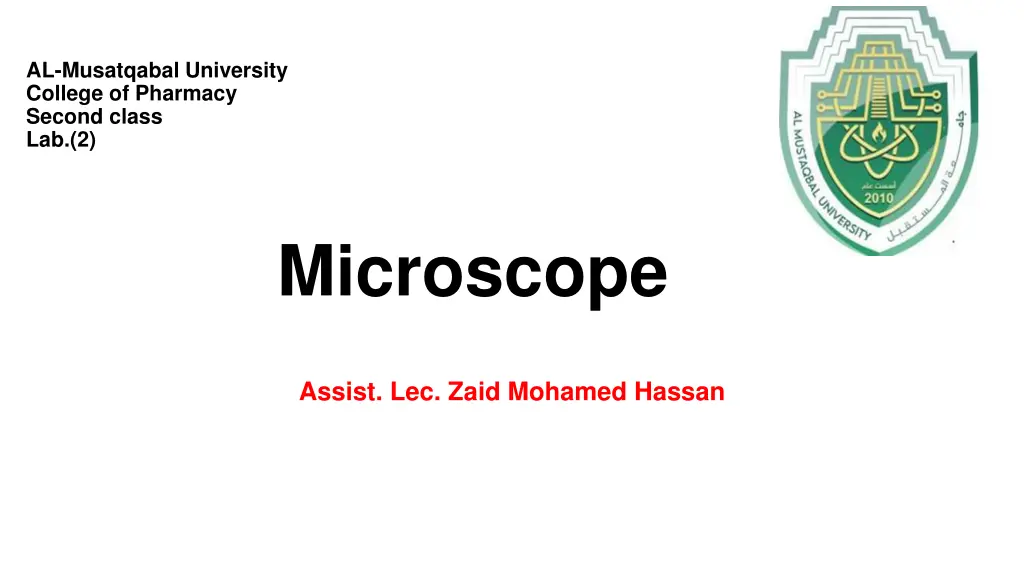
Understanding Microscopes: Types, Functions, and Applications
Microscopes are essential instruments in scientific laboratories for visualizing minute objects and microorganisms. They consist of various types like light microscopes, electron microscopes, etc., with unique functions and applications. Learn how microscopes work and the significance of different specimen tubes used in laboratories.
Download Presentation

Please find below an Image/Link to download the presentation.
The content on the website is provided AS IS for your information and personal use only. It may not be sold, licensed, or shared on other websites without obtaining consent from the author. If you encounter any issues during the download, it is possible that the publisher has removed the file from their server.
You are allowed to download the files provided on this website for personal or commercial use, subject to the condition that they are used lawfully. All files are the property of their respective owners.
The content on the website is provided AS IS for your information and personal use only. It may not be sold, licensed, or shared on other websites without obtaining consent from the author.
E N D
Presentation Transcript
AL-Musatqabal University College of Pharmacy Second class Lab.(2) Microscope Assist. Lec. Zaid Mohamed Hassan
Microscopes are instruments used in science laboratories to visualize very minute objects, microorganisms, giving a magnified. Microscopes are made up of lenses for magnification, each with its magnification powers. Depending on the lens type, it will magnify the specimen according to its focal strength. Their ability to function is because they have been constructed with special components that enable them to achieve high magnification levels. They can view very small specimens and distinguish their structural differences, for example, the view of viewing microscopic bacterial cells. such as image cells and contrasting that is animal and plant cells
There are different types of microscopes like light microscopes, dark-field microscopes, phase contrast microscopes, fluorescent microscopes, etc. Microscopes are generally made up of structural parts for holding and supporting the microscope and its components and the optical parts that are used for magnification and viewing of the specimen images. Modern microscopes have additional electronics and display devices. electron microscopes,
How Does Microscope Work? In a simple light microscope, a thin specimen containing a slide is placed on the microscope s stage. A beam of light is passed through the condenser to the specimen. The light transmitted from the specimen enters the objective lens. While passing through the objectives, the transmitted rays appear to come from the bigger objects. The light is then focused on the eyepiece lens. This lens further magnifies the pre-magnified image coming from the objectives. Finally, a highly magnified image can be observed.
Purple one tube (lavender): this tube is generally used for hematology tests where whole blood is required for analysis. This tube contains EDTA (ethylenediaminetetraacetic acid), which acts as a potent anticoagulant by binding to calcium in the blood. Uses : Full blood count Erythrocyte sedimentation rate (ESR) Blood film HbA1c
Blue tube: contains buffered sodium citrate which acts as a reversible anticoagulant by binding to calcium ions in blood. Uses : Bleeding time. Prothrombin time (PT). D- dimer for thrombosis (DVT, PE).
The dark green tube; This less commonly used bottle is for biochemistry, requiring heparinized plasma or whole blood for analysis. this contains sodium heparin which acts as an anticoagulant. Common tests; Ammonia. Insulin. Renin and aldosterone
Yellow tubes (clot activator tubes) used for various tests require separated serum for analysis including biochemistry, oncology, endocrinology, microbiology, and immunology. Common tests: Urea and electrolyte tests. C-reactive protein (CRP). Liver function tests. Serum iron, ferritin. Lipid profile. Thyroid function tests.






















